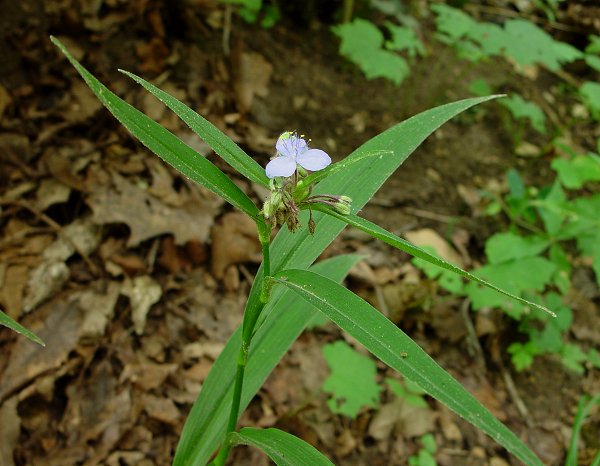Tradescantia subaspera Ker Gawl.
Wide-Leaved Spiderwort

Native
CC = 8
CW = 5
MOC = 39
© DETenaglia
Tradescantia subaspera Ker Gawl.Wide-Leaved Spiderwort | |
 |
Native CC = 8 CW = 5 MOC = 39 |
© DETenaglia |
|
Family - Commelinaceae Habit - Perennial forb, from fibrous to slightly thickened roots. Stems - Ascending to erect, to 1 m, usually strongly zigzag in the upper half, hairy or glabrous.
Leaves - Alternate, sheathing at base, linear-lanceolate, entire, to 25 cm long, 5 cm broad, tapering abruptly above the base and conspicuously broader than the sheaths, glabrous or sparsely hairy, usually ciliate along the margins near the base, deep green.
Inflorescence - Terminal and axillary sessile bracteate clusters. Flower stalks 10-17 mm long, pubescent with glandtipped, nonglandular, or mixed hairs, or less commonly nearly glabrous.
Flowers - Sepals 3, 4-10 mm long, green, sometimes tinged with purple, herbaceous, pubescent with gland-tipped, nonglandular, or mixed hairs, or less commonly glabrous. Petals 3, 10-15 mm long, light blue to deep blue. Stamens 6, erect. Filaments to 8 mm long, purple, with dense purple multicellular pilose pubescence. Anthers yellow, 2 mm broad. Ovary superior, white, globose, 1.5 mm in diameter, with multicellular pubescence at apex. Style to 4 mm long, purple, glabrous.
Fruits - Capsules 4-8 mm long, ovoid, 3-locular. Seeds 3-6 per capsule, 2-3 mm long, oblong to ovoid and somewhat flattened with a depression on 1 side, the surfaces undulate to bluntly several-ribbed. Flowering - June - September. Habitat - Mesic and bottomland forests, often in ravines, shaded stream banks, shaded bluffs, frequently on calcareous substrates. Origin - Native to the U.S. Other info. - This is another species of the familiar genus Tradescantia, commonly called spiderworts. This is not, however, the most common species found throughout most of the state. That designation belongs to T. ohiensis, which differs from the above species by having longer thinner leaves, typically straight stems, and sepals and pedicels which are glabrous. T. subaspera is found mainly in the eastern half of the state and grows in shaded areas of the habitats mentioned above. Most of the plant's global range is within Missouri and four additional states to our east. Our plants belong to variety subaspera. Another variety, var. montana (Shuttlew.) Anders. & Woods., grows in more southeastern U.S. states. The latter variety has typically straight stems and axillary inflorescences which are on peduncles. Photographs taken in Big Spring Park, MO., 7-18-03 (DETenaglia); also at Daniel Boone Conservation Area, Warren County, MO, 5-17-2008, Shaw Nature Reserve, Franklin County, MO, 8-17-2008, Meramec State Park, Franklin County, MO, 9-3-2010, and Danville Conservation Area, Montgomery County, MO, 6-27-2017 (SRTurner). |